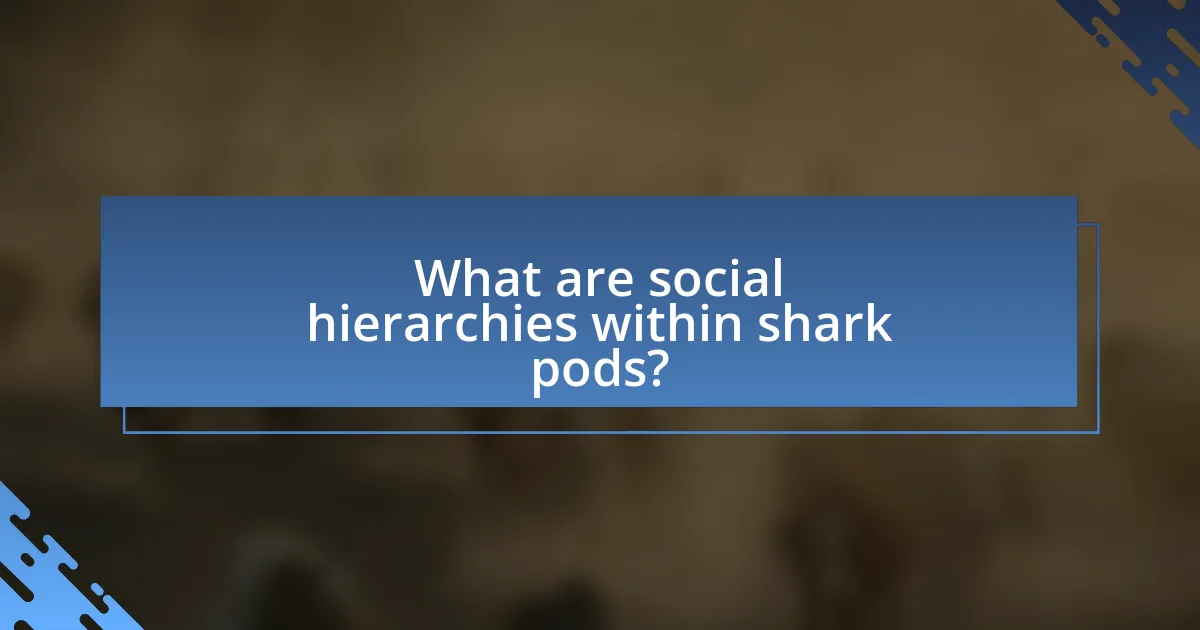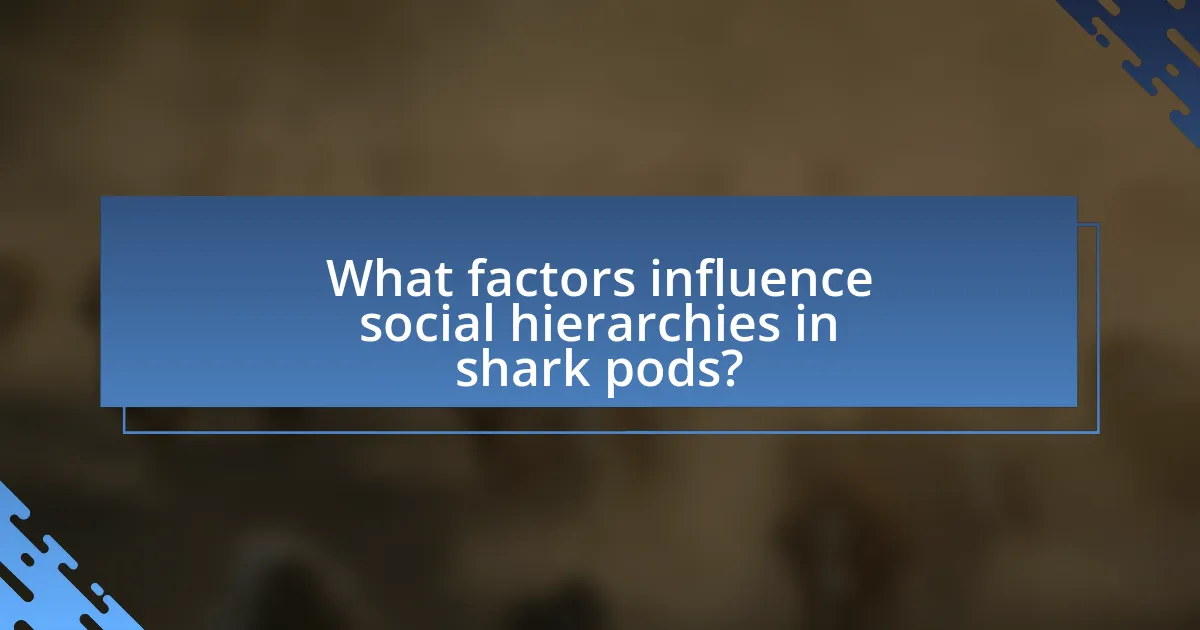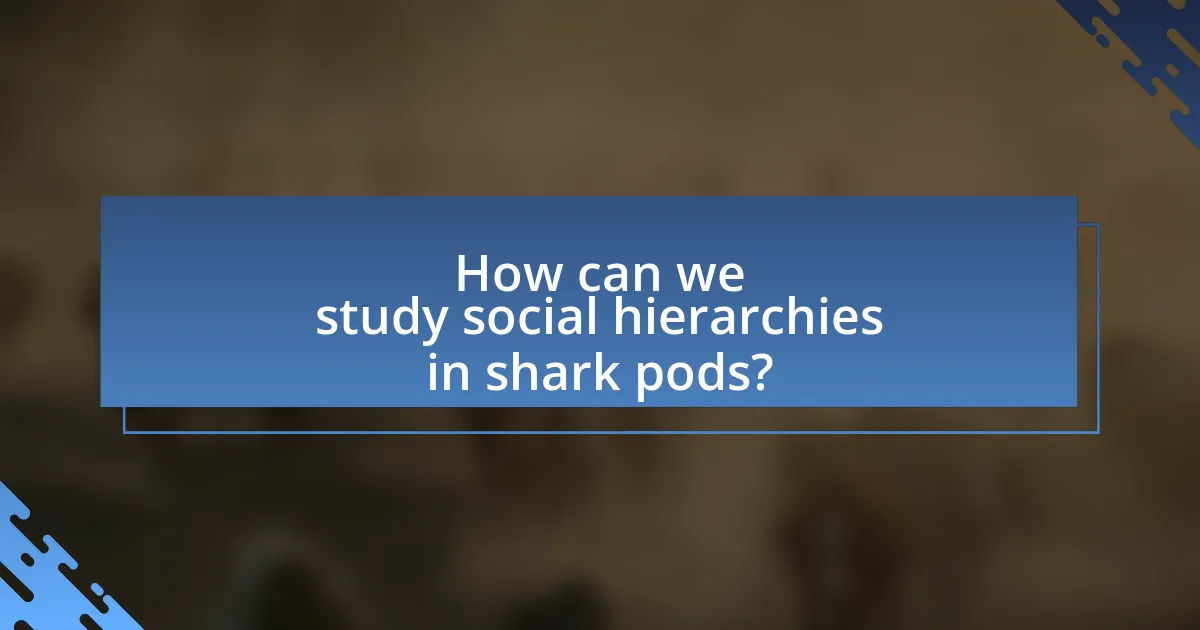Social hierarchies within shark pods refer to the structured social organization observed among certain shark species, such as blacktip reef sharks and great white sharks. Research indicates that these hierarchies manifest through dominance behaviors, size, and social interactions, influencing feeding patterns and mating opportunities. The article explores how factors like size, age, sex, and environmental context shape these hierarchies, while also addressing the ongoing debate regarding their existence and implications for shark behavior and conservation. Evidence supporting these hierarchies includes observed dominance displays and spatial organization, although some studies challenge the notion of rigid social structures, suggesting more fluid interactions among sharks. Understanding these dynamics is crucial for effective management and conservation strategies aimed at protecting shark populations.

What are social hierarchies within shark pods?
Social hierarchies within shark pods refer to the structured social organization that can exist among sharks in a group. Research indicates that certain species of sharks, such as the blacktip reef shark, exhibit dominance hierarchies where larger or more aggressive individuals often assert control over resources and mating opportunities. Observations have shown that these hierarchies can influence behaviors such as feeding and social interactions, with dominant sharks often having priority access to food and mates. Studies, including those by researchers like Dr. Yannis Papastamatiou, have documented these social structures, providing evidence that social hierarchies are indeed a reality in some shark populations.
How do social hierarchies manifest in shark pods?
Social hierarchies in shark pods manifest through dominance behaviors, size, and social interactions among individuals. Larger and more aggressive sharks often establish themselves as leaders, influencing the movement and feeding patterns of the group. Research indicates that these hierarchies can be observed in species such as the great white shark, where dominant individuals exhibit priority access to food resources and mating opportunities. Studies have shown that social structures in shark pods can lead to increased survival rates, as coordinated hunting and protection from threats are more effective when hierarchies are established.
What behaviors indicate a social hierarchy among sharks?
Social hierarchies among sharks are indicated by behaviors such as dominance displays, spatial organization, and feeding order. Dominance displays include aggressive posturing and physical confrontations, which establish rank within a group. Spatial organization is observed when larger or more dominant sharks occupy prime locations in a habitat, influencing access to resources. Feeding order is evident when dominant individuals feed first during a meal, often leading to a clear hierarchy based on size and strength. These behaviors have been documented in various studies, including research by Heithaus et al. (2008), which highlights the social structures and interactions within shark populations.
How do different species of sharks exhibit social hierarchies?
Different species of sharks exhibit social hierarchies primarily through dominance behaviors and spatial organization within their groups. For instance, studies have shown that species like the great white shark and the tiger shark display clear dominance hierarchies, where larger individuals often assert control over feeding opportunities and mating rights. Research conducted by researchers such as Dr. David Jacoby indicates that social structures can be influenced by factors like size, age, and sex, leading to a ranking system that affects interactions among individuals. Additionally, in species like the hammerhead shark, social hierarchies can manifest in coordinated hunting strategies, where dominant individuals lead the group, showcasing a structured social dynamic.
Why is the concept of social hierarchies in shark pods debated?
The concept of social hierarchies in shark pods is debated due to conflicting observations regarding their social structures and behaviors. Some researchers argue that sharks exhibit hierarchical behaviors, such as dominance displays and social interactions, suggesting a structured social order. Conversely, other studies indicate that sharks may be more solitary and opportunistic, lacking consistent social hierarchies. For instance, a study published in the journal “Marine Biology” by researchers from the University of Miami found that while certain species of sharks display social behaviors, these do not necessarily translate into stable hierarchies. This ongoing debate highlights the complexity of shark social dynamics and the need for further research to clarify their social organization.
What evidence supports the existence of social hierarchies in sharks?
Evidence supporting the existence of social hierarchies in sharks includes observed behaviors such as dominance displays, spatial organization, and feeding patterns. Research indicates that larger and more aggressive shark species often dominate feeding areas, influencing the behavior of smaller individuals. For instance, studies have shown that in species like the blacktip reef shark, individuals establish dominance hierarchies based on size and aggression, which affects access to resources. Additionally, social interactions among sharks, such as the establishment of territories and the formation of groups, further illustrate hierarchical structures. These behaviors have been documented in various studies, including those published in the journal “Marine Ecology Progress Series,” which detail the social dynamics and interactions within shark populations.
What arguments challenge the idea of social hierarchies in shark pods?
Arguments challenging the idea of social hierarchies in shark pods include observations of egalitarian behavior and the lack of consistent dominance patterns among individuals. Research indicates that sharks often exhibit cooperative behaviors, such as hunting in groups without a clear leader, suggesting a more fluid social structure. Additionally, studies have shown that interactions among sharks can vary widely based on environmental factors and individual personalities, undermining the notion of rigid hierarchies. For instance, a study published in the journal “Animal Behaviour” by researchers from the University of Miami found that social interactions among bull sharks were influenced more by situational context than by established dominance, indicating that social structures may be more complex and less hierarchical than previously thought.

What factors influence social hierarchies in shark pods?
Social hierarchies in shark pods are influenced primarily by factors such as size, age, sex, and social interactions among individuals. Larger and older sharks often dominate due to their physical strength and experience, which allows them to assert control over resources and mating opportunities. Additionally, male and female sharks exhibit different social behaviors, with males often competing for access to females, thereby establishing a hierarchy based on reproductive success. Social interactions, including aggression and cooperation, further shape these hierarchies, as sharks establish dominance through encounters that can reinforce or challenge existing social structures. Research indicates that these dynamics are not merely anecdotal but are supported by observations of behavior in species like the great white shark and the tiger shark, where size and sex play critical roles in social organization.
How does environmental context affect shark social structures?
Environmental context significantly influences shark social structures by determining their spatial distribution, foraging behavior, and interactions with other species. For instance, factors such as water temperature, salinity, and the availability of prey can lead to the formation of distinct social groups or pods. Research indicates that in areas with abundant food resources, sharks are more likely to exhibit social behaviors, forming hierarchies based on size and dominance, as seen in species like the great white shark. Additionally, environmental conditions can affect migration patterns, which in turn influence social dynamics; for example, during breeding seasons, sharks may congregate in specific locations, leading to increased social interactions and competition.
What role does food availability play in shaping hierarchies?
Food availability significantly influences the formation of hierarchies within shark pods. In environments where food is scarce, competition for resources intensifies, leading to the establishment of dominance hierarchies among sharks. Research indicates that dominant individuals often have preferential access to food, which reinforces their status and allows them to maintain control over feeding opportunities. For example, studies have shown that larger and more aggressive sharks tend to dominate feeding events, thereby securing more resources and further entrenching their hierarchical position. This dynamic illustrates how food availability directly impacts social structures and behaviors within shark pods.
How do mating behaviors influence social dynamics in shark pods?
Mating behaviors significantly influence social dynamics in shark pods by establishing dominance hierarchies and affecting group cohesion. During mating seasons, male sharks often engage in competitive displays and aggressive interactions to secure mating opportunities, which can lead to the formation of temporary hierarchies based on size and strength. Research indicates that these behaviors can alter the social structure within pods, as dominant males may gain preferential access to females, thereby impacting the overall social interactions among pod members. For instance, studies have shown that in species like the great white shark, males exhibit increased aggression and territoriality during mating periods, which can disrupt established social bonds and lead to shifts in group dynamics.
What are the implications of social hierarchies for shark behavior?
Social hierarchies significantly influence shark behavior by dictating access to resources, mating opportunities, and social interactions. Research indicates that dominant sharks often exhibit aggressive behaviors to maintain their status, which can lead to increased competition among individuals within a pod. For instance, studies have shown that larger, more dominant individuals tend to have priority access to food sources, impacting the foraging strategies of subordinate sharks. Additionally, social hierarchies can affect reproductive success, as dominant males may have greater access to females during mating seasons, thereby influencing genetic diversity within populations.
How do hierarchies affect competition among sharks?
Hierarchies significantly influence competition among sharks by establishing dominance and access to resources. In shark pods, dominant individuals often secure better feeding opportunities and mating rights, which can lead to increased survival and reproductive success. Research indicates that species like the great white shark exhibit social structures where larger, more aggressive individuals assert control over smaller ones, thereby limiting their access to food and mates. This competitive dynamic is evident in studies showing that dominant sharks can monopolize prey, impacting the overall foraging efficiency of the group.
What impact do social structures have on shark reproduction?
Social structures significantly influence shark reproduction by affecting mating behaviors and reproductive success. In species such as the great white shark, social hierarchies can dictate access to mates, with dominant individuals often having greater reproductive opportunities. Research indicates that in some shark species, such as the blacktip reef shark, social interactions and group dynamics can enhance mating success, as individuals may engage in courtship displays that are more effective within established social groups. Additionally, the presence of social structures can lead to increased competition among males, which may drive the evolution of specific reproductive strategies, such as larger size or more aggressive behaviors during mating seasons.

How can we study social hierarchies in shark pods?
To study social hierarchies in shark pods, researchers can utilize methods such as behavioral observation, tagging and tracking, and genetic analysis. Behavioral observation allows scientists to monitor interactions and dominance displays among individual sharks, providing insights into their social structure. Tagging and tracking technologies, like GPS and acoustic tags, enable the collection of movement patterns and social associations over time, revealing how sharks interact within pods. Genetic analysis can further clarify relationships among individuals, helping to identify kinship and social bonds. Studies, such as those conducted by researchers like Dr. Neil Hammerschlag, have demonstrated that these methods can effectively reveal complex social dynamics in shark populations, supporting the existence of hierarchies within pods.
What research methods are used to observe shark social behavior?
Research methods used to observe shark social behavior include underwater video monitoring, acoustic telemetry, and direct observation. Underwater video monitoring allows researchers to capture real-time interactions among sharks in their natural habitat, providing visual evidence of social dynamics. Acoustic telemetry involves tagging sharks with transmitters to track their movements and interactions over time, revealing patterns of social behavior and group dynamics. Direct observation, often conducted by divers or from boats, enables researchers to document behaviors and interactions in situ, contributing to a deeper understanding of social hierarchies within shark pods. These methods collectively enhance the understanding of shark social structures and behaviors.
How do scientists track and analyze shark interactions?
Scientists track and analyze shark interactions using various methods, including acoustic telemetry, satellite tagging, and direct observation. Acoustic telemetry involves placing transmitters on sharks that send signals to underwater receivers, allowing researchers to monitor their movements and interactions in real-time. Satellite tagging provides data on long-distance movements and behaviors by sending location information to satellites. Direct observation, often conducted through underwater cameras or diver surveys, allows scientists to record social behaviors and interactions among sharks. These methods collectively contribute to understanding the social hierarchies within shark pods, revealing patterns of behavior and interaction that inform the debate on whether such hierarchies exist.
What technologies aid in studying shark social hierarchies?
Technologies that aid in studying shark social hierarchies include acoustic telemetry, underwater video monitoring, and genetic analysis. Acoustic telemetry allows researchers to track the movements and interactions of individual sharks in real-time, providing insights into their social behaviors and hierarchies. Underwater video monitoring captures visual data on shark interactions, enabling the observation of social structures and group dynamics. Genetic analysis helps in understanding kinship and relatedness among sharks, which can reveal patterns of social organization. These technologies collectively enhance the understanding of social hierarchies within shark pods, supporting findings from studies such as those published in the journal “Marine Biology.”
What challenges do researchers face in studying shark hierarchies?
Researchers face significant challenges in studying shark hierarchies due to the elusive nature of sharks and their complex social behaviors. The difficulty in observing sharks in their natural habitats, often in deep or murky waters, limits the ability to gather consistent data on their interactions and social structures. Additionally, the variability in species-specific behaviors complicates the establishment of a universal framework for understanding hierarchies among different shark species. Studies have shown that factors such as environmental conditions, prey availability, and individual personalities can influence social dynamics, making it challenging to draw definitive conclusions about hierarchical structures.
How does the elusive nature of sharks complicate research?
The elusive nature of sharks complicates research by making it difficult for scientists to observe and study their behavior in natural habitats. Sharks often inhabit vast oceanic areas and exhibit migratory patterns that can span thousands of miles, which limits researchers’ ability to track and monitor them consistently. For instance, studies have shown that species like the great white shark can travel over 2,000 miles in a single migration, making it challenging to gather data on their social interactions and hierarchies. Additionally, their natural camouflage and ability to remain submerged for extended periods further hinder direct observation, resulting in gaps in knowledge about their social structures within pods.
What limitations exist in current studies of shark social behavior?
Current studies of shark social behavior face several limitations, primarily due to the challenges in observing sharks in their natural habitats. These limitations include the difficulty of tracking individual sharks over time, which hinders the understanding of their social interactions and hierarchies. Additionally, many studies rely on small sample sizes, which can lead to inconclusive results and limit the generalizability of findings. Furthermore, the use of artificial environments in some research may not accurately reflect natural behaviors, leading to potential misinterpretations of social dynamics. These factors collectively restrict the depth and accuracy of insights into shark social behavior.
What practical insights can be gained from understanding shark social hierarchies?
Understanding shark social hierarchies provides practical insights into their behavior, ecology, and conservation strategies. Research indicates that sharks exhibit social structures that influence their feeding patterns, mating behaviors, and territoriality. For instance, studies have shown that dominant individuals often have priority access to food resources, which can affect the overall health of shark populations. Additionally, recognizing these hierarchies can aid in the development of effective conservation measures, as protecting key individuals within a social structure can enhance the resilience of shark populations. Understanding these dynamics is crucial for managing fisheries and marine ecosystems, as it allows for more informed decisions regarding habitat protection and species interactions.
How can knowledge of shark hierarchies inform conservation efforts?
Knowledge of shark hierarchies can significantly inform conservation efforts by enabling targeted management strategies that consider social structures within shark populations. Understanding these hierarchies allows researchers to identify key individuals that play crucial roles in the social dynamics of shark pods, which can influence breeding success and population stability. For instance, studies have shown that dominant individuals often have better access to resources and mates, impacting genetic diversity and resilience of the population. By focusing conservation efforts on protecting these key individuals and their habitats, conservationists can enhance the overall health and sustainability of shark populations.
What best practices can be derived for managing shark populations?
Best practices for managing shark populations include implementing sustainable fishing regulations, establishing marine protected areas, and conducting regular population assessments. Sustainable fishing regulations, such as catch limits and seasonal closures, help prevent overfishing and allow shark populations to recover. Marine protected areas provide safe habitats where sharks can thrive without human interference, contributing to biodiversity and ecosystem health. Regular population assessments, using methods like tagging and monitoring, ensure that management strategies are based on accurate data, allowing for adaptive management in response to changing population dynamics. These practices are supported by research indicating that well-managed shark populations can enhance marine ecosystems and support fisheries.


